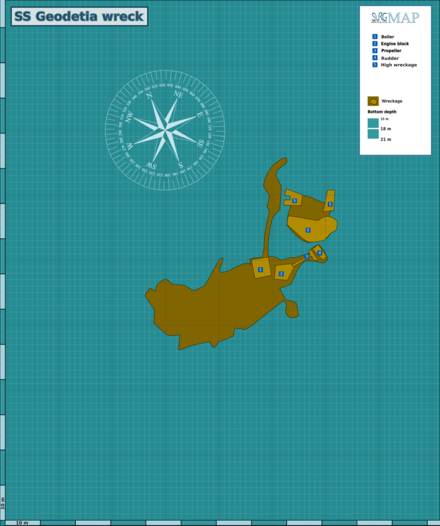Diving the Cape Peninsula and False Bay/ST Godetia
Diving the Cape Peninsula and False Bay/ST Godetia
The dive site SS Godetia is an offshore recent wreck in the northern part of False Bay, near the Cape Town suburb Macassar in the Western Cape province of South Africa.
Understand
 See also: Diving the Cape Peninsula and False Bay#Understand
See also: Diving the Cape Peninsula and False Bay#Understand
The ST Godetia was a steel steam side-trawler in the Irvin and Johnson fleet, which was sunk by the SA Air force as target practice in August 1970. The ship was built by Hall Russel & Co. Ltd. of Aberdeen as Yard #794, launched on 30 April 1946 by the wife of Richard Irvin of Richard Irvin and Sons, Ltd, Aberdeen. The vessel was long, with a beam and a hull depth of and was 515 gross registered tons. It was powered by a single coal fired scotch boiler and triple expansion steam engine driving a single shaft with a 4-bladed propeller.
The wreck was located by a small group of divers on the dive boat Ruby Runner, launched from Harbour Island on 4 August 2018, on an unusually calm sea. After reaching the charted position, the boat made several passes of a parallel linear search pattern using the fish-finder, and picked up a few possible hits. After about an hour two points were selected for visual search, and the second team found that their shotline had been dropped on top of the boiler. The group investigated further and mapped the extents of the debris field and position of major artifacts using a towed float with GPS tracker. The track recorded was used to draw the map.
Position
S34°06.???' E19°44.???' ST Godetia wreck 📍, about 2.7 km offshore of Macassar. This site is not in a Marine Protected Area. A permit is not required.
Name
The name "ST Godetia" is the name of the vessel sunk at the site. ST stands for Steam Trawler, and Godetia is the name of a flower.
Depth
Maximum depth is about 18 m on the sand, and the top of the boiler is at about 14 m. (Average depth of a dive is likely to be about 16 m)
Visibility
This is an area where the south westerly swells usually reach the shore, and the surge will usually be significant. Visibility is likely to be poor most of the time, though it was about 10 m on the day the wreck was found. This is probably unusually good.
Topography
The bottom in this area is scattered patches of low to medium profile rocky reef on sand.
Geology: The reef is sedimentary rock, probably of the Pre-Cambrian Tygerberg formation of the Malmesbury Group, which forms the regional geological basement in the Cape peninsula. The strike is roughly north/south, and the dip appears to be very steep.
Conditions
The site is exposed to south westerly swell, and wind from all directions, though the fetch is relatively short for winds from the north, so should be dived in calm conditions with low swell.
Get in
See also: Diving the Cape Peninsula and False Bay#Boat dives
The site is too far offshore for shore dives, and can only be dived from a boat. The site is about 12.5 km from Harbour Island, 13.6 km from Gordon's Bay Old Harbour, and 29.5 km from Simon's Town jetty.
See
Marine life
See also: Diving the Cape Peninsula and False Bay#The marine ecology
Features
Wreckage of a steel hulled steam trawler. Most of the hull structure is thoroughly broken up, but the boiler, engine block, propeller, and rudder blade are clustered together, and would form the focal point of a dive. <gallery mode="packed"> File:Divers returning to the boat at the wreck of the SS Godetia P8040937.jpg|Divers returning to the boat File:Boiler of the SS Godetia P8040843.jpg|Boiler File:Rudder blade of the SS Godetia P8040693.jpg|Rudder blade File:Propeller of the SS Godetia P8040691.jpg|Propeller File:Diver at the boiler of the SS GodetiaP8040539.jpg|Diver at the boiler File:Grating at the wreck of the SS Godetia P8040524.jpg|Grating File:Boiler of SS Godetia wreck P8040508.jpg|Top of the boiler </gallery>
Photography
If the visibility is good, wide angle or fisheye photography may give good results, otherwise there is a lot of encrusting invertebrate growth and macro is likely to give better results. The water is fairly shallow, and natural lighting may be quite good, but it is worth taking a flash or video light.
Suggested routes
There are no specific routes recommended, but the area around the boiler and to the east have the largest and most identifiable wreckage fragments.
Stay safe
See also: Diving the Cape Peninsula and False Bay#Stay safe
Hazards
This is an area known to be frequented by cruising great white sharks at some times of the year, and there is a section of wreckage with a space underneath which is large enough to swim underneath, that could be a hazard.
Skills
No special skills are required. The site is shallow enough for entry level divers.
Equipment
See also: Diving the Cape Peninsula and False Bay#Equipment
No special equipment recommended.
Nearby
Other offshore dive sites of False Bay:
Back to the Alphabetical list of sites, or list of wreck dive sites in the False Bay offshore area
Other regional dive sites: